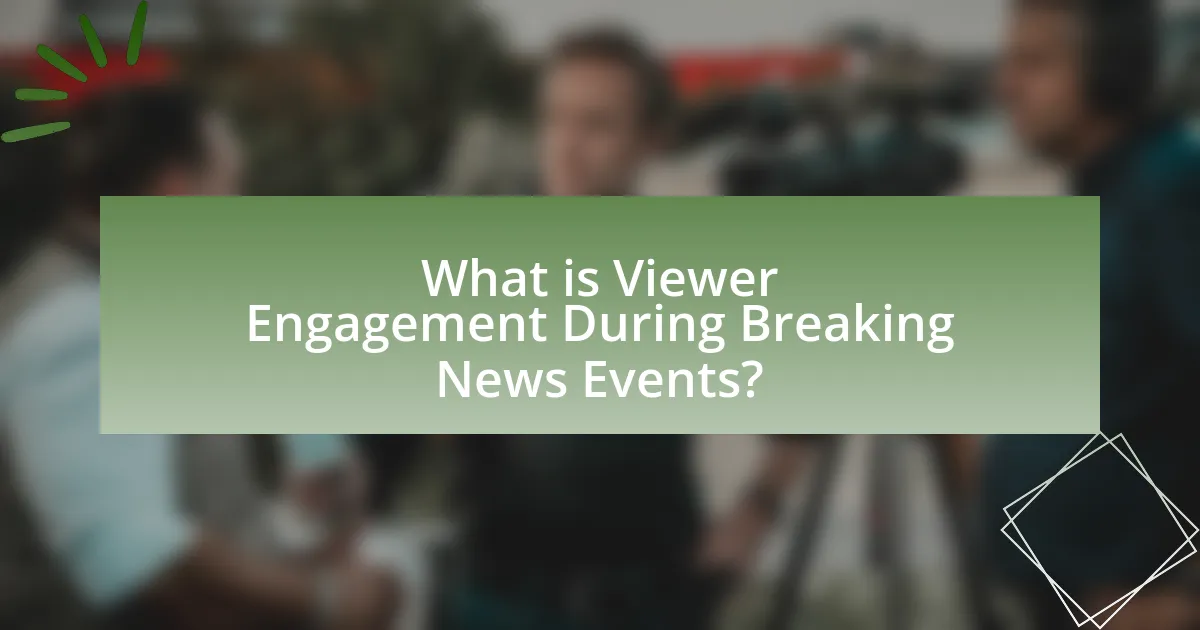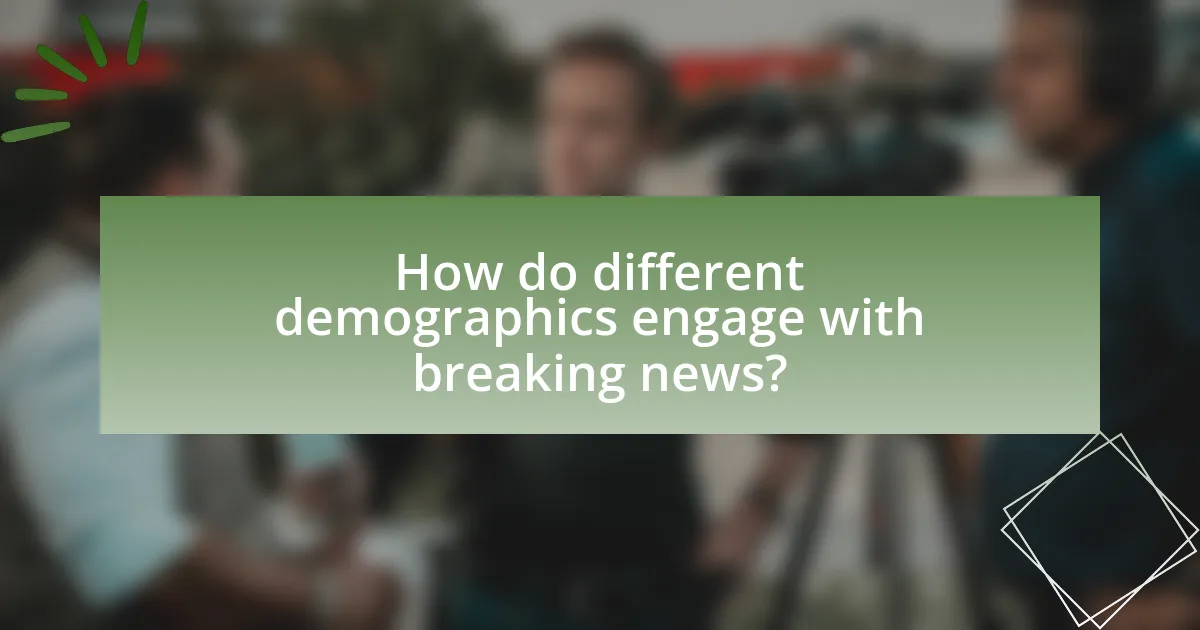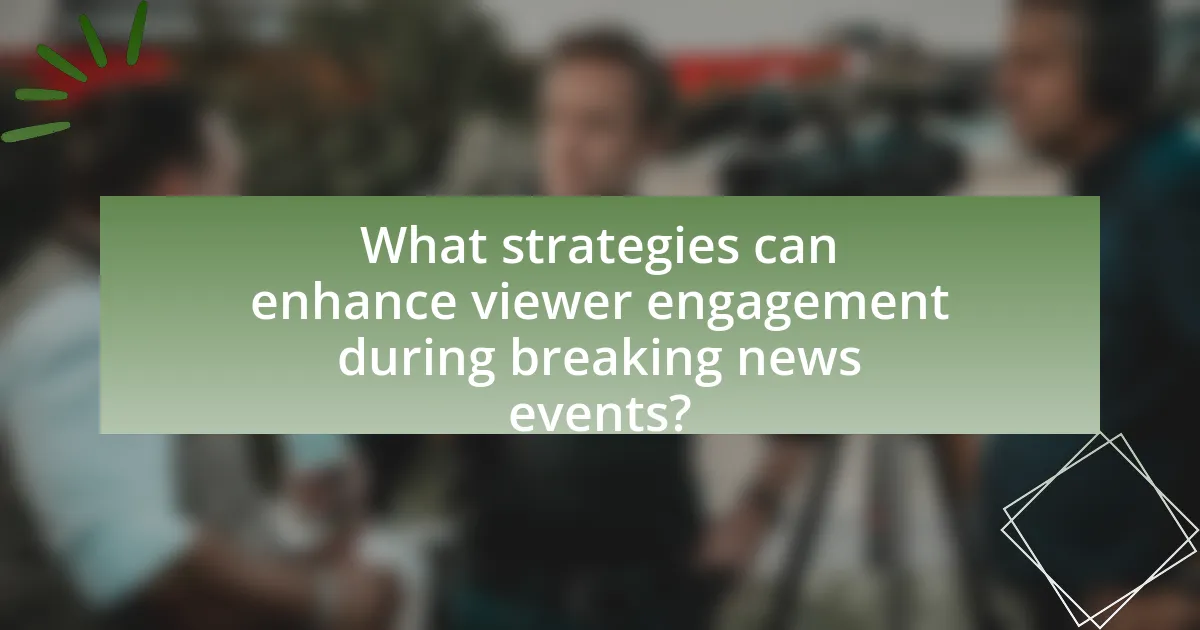Viewer engagement during breaking news events is defined as the level of interest and interaction exhibited by audiences in response to urgent news coverage. This article analyzes how viewer engagement is measured through various metrics, including ratings, social media interactions, and website traffic, and explores the factors that influence engagement, such as the immediacy of information and the emotional impact of events. It also examines the role of different media platforms, demographic factors, and technology usage in shaping viewer engagement, as well as effective strategies for news organizations to enhance audience participation during critical news events.

What is Viewer Engagement During Breaking News Events?
Viewer engagement during breaking news events refers to the level of interest and interaction that audiences exhibit in response to urgent news coverage. This engagement is typically characterized by increased viewership, social media activity, and audience participation through comments and shares. Research indicates that during significant events, such as natural disasters or political crises, viewership can spike dramatically, with some networks reporting increases of over 100% in audience numbers compared to regular programming. Additionally, social media platforms see heightened activity, with users sharing updates and engaging in discussions, which further amplifies the reach and impact of the news coverage.
How is viewer engagement measured during breaking news events?
Viewer engagement during breaking news events is measured through metrics such as ratings, social media interactions, and website traffic. Television ratings provide data on the number of viewers watching a broadcast, while social media interactions, including likes, shares, and comments, indicate audience participation and sentiment. Additionally, spikes in website traffic during breaking news coverage reflect increased interest and engagement from online audiences. For instance, Nielsen reported that major breaking news events can lead to significant increases in viewership, with some events drawing millions of viewers in real-time.
What metrics are commonly used to assess viewer engagement?
Common metrics used to assess viewer engagement include viewership ratings, average watch time, audience retention rate, and interaction metrics such as likes, shares, and comments. Viewership ratings provide a quantitative measure of how many people are watching a broadcast, while average watch time indicates the duration viewers spend watching content, reflecting their interest level. Audience retention rate measures the percentage of viewers who continue watching throughout the broadcast, highlighting content effectiveness. Interaction metrics, such as likes and shares, gauge viewer response and engagement with the content, providing insight into audience sentiment and involvement. These metrics collectively offer a comprehensive view of viewer engagement during breaking news events.
How do these metrics vary across different media platforms?
Metrics such as viewer engagement, reach, and interaction rates vary significantly across different media platforms during breaking news events. For instance, television typically garners higher viewer engagement through live broadcasts, with Nielsen reporting that live TV viewing peaks during major news events, often exceeding millions of viewers simultaneously. In contrast, social media platforms like Twitter and Facebook see rapid spikes in interaction rates, with users sharing and commenting on news stories, as evidenced by a Pew Research study indicating that 62% of adults get news from social media. Additionally, online news websites experience increased traffic, with analytics showing that unique visitors can double during breaking news, highlighting the shift in how audiences consume information across platforms.
Why is viewer engagement important during breaking news events?
Viewer engagement is crucial during breaking news events because it enhances the dissemination of information and fosters a sense of community among viewers. Engaged audiences are more likely to share news updates on social media, which amplifies the reach and impact of the information being reported. According to a study by the Pew Research Center, 62% of adults in the U.S. get news from social media, indicating that viewer engagement directly influences how widely news is spread. Additionally, high engagement levels can lead to increased ratings and advertising revenue for news organizations, as they attract more viewers during critical events.
What impact does high viewer engagement have on news organizations?
High viewer engagement significantly enhances the financial stability and credibility of news organizations. Increased viewer engagement leads to higher advertising revenues, as advertisers are more likely to invest in platforms with larger audiences. For instance, a study by the Pew Research Center found that news organizations with higher engagement metrics, such as view counts and social media interactions, reported a 30% increase in ad revenue compared to those with lower engagement. Additionally, high engagement fosters trust and loyalty among viewers, which can result in increased subscriptions and donations, further solidifying the organization’s financial foundation.
How does viewer engagement influence public perception of news events?
Viewer engagement significantly influences public perception of news events by shaping the narrative and framing the information presented. High levels of engagement, such as shares, comments, and likes, can amplify certain viewpoints and create a perception of consensus or urgency around specific issues. For instance, research by the Pew Research Center indicates that stories with higher engagement metrics are often perceived as more credible and important by the audience, leading to a skewed understanding of the event’s significance. This phenomenon occurs because engaged viewers are more likely to discuss and disseminate the content, thereby reinforcing particular narratives and potentially overshadowing alternative perspectives.
What factors affect viewer engagement during breaking news events?
Viewer engagement during breaking news events is primarily affected by the immediacy of the information, the credibility of the news source, and the emotional impact of the event. Immediacy drives viewers to seek real-time updates, as evidenced by a Pew Research Center study showing that 63% of Americans prefer to receive news as it happens. Credibility influences trust; viewers are more likely to engage with reputable sources, with 73% of respondents in a Gallup poll indicating they trust local news organizations. Emotional impact, such as fear or excitement, significantly boosts engagement, as demonstrated by research from the University of Pennsylvania, which found that emotionally charged stories lead to higher viewer retention and sharing rates.
How do the nature and urgency of the news impact viewer interest?
The nature and urgency of the news significantly impact viewer interest by influencing the emotional response and perceived relevance of the information. Urgent news, such as natural disasters or terrorist attacks, tends to attract more viewers due to heightened emotional engagement and the immediate need for information. For instance, during the 9/11 attacks, viewership for news channels surged, with CNN reporting a 1,000% increase in audience. Additionally, the nature of the news—whether it is local, national, or international—affects viewer interest, as people are generally more engaged with news that directly impacts their lives. Studies show that breaking news stories that evoke strong emotions, such as fear or empathy, lead to increased viewer retention and engagement.
What role does social media play in shaping viewer engagement?
Social media significantly shapes viewer engagement by providing real-time updates and facilitating interaction during breaking news events. Platforms like Twitter and Facebook allow users to share information instantly, which enhances the immediacy of news consumption. According to a Pew Research Center study, 53% of social media users reported that they often get news from these platforms, indicating their crucial role in disseminating information quickly. Additionally, social media fosters community discussions and reactions, which can amplify viewer engagement through likes, shares, and comments, creating a participatory environment that traditional media lacks.

How do different demographics engage with breaking news?
Different demographics engage with breaking news through varying platforms and formats, influenced by factors such as age, education, and technology access. For instance, younger audiences, particularly those aged 18-29, predominantly utilize social media platforms like Twitter and Instagram for real-time updates, with 55% reporting they often get news from these sources, according to the Pew Research Center. In contrast, older demographics, such as those aged 50 and above, tend to rely more on traditional media outlets like television and newspapers, with 65% of this group indicating they prefer these formats for news consumption. Additionally, educational background affects engagement; individuals with higher education levels are more likely to seek out in-depth analysis and diverse viewpoints, often accessing news through online articles and podcasts. This demographic variation highlights the importance of tailored news delivery methods to effectively reach and engage different audience segments during breaking news events.
What demographic factors influence viewer engagement levels?
Demographic factors that influence viewer engagement levels include age, gender, education, and socioeconomic status. Research indicates that younger audiences, particularly those aged 18-34, tend to engage more with digital platforms during breaking news events compared to older demographics, who may prefer traditional media. Gender differences also play a role, as studies show that women are more likely to engage with news content on social media, while men often prefer television news. Additionally, higher education levels correlate with increased engagement, as educated individuals are more likely to seek out diverse news sources. Socioeconomic status impacts access to technology and media consumption habits, with higher-income individuals typically having greater access to multiple platforms, leading to higher engagement levels. These insights are supported by data from the Pew Research Center, which highlights the relationship between demographic characteristics and media consumption patterns.
How do age and gender affect engagement with breaking news?
Age and gender significantly influence engagement with breaking news, as younger audiences tend to consume news through digital platforms while older demographics prefer traditional media. Research indicates that individuals aged 18-29 are more likely to engage with breaking news via social media, with 62% reporting they get news from these platforms, compared to only 24% of those aged 65 and older. Gender differences also emerge, with studies showing that women are more likely to engage with news related to social issues and health, while men often show higher engagement with sports and politics. This pattern is supported by data from the Pew Research Center, which highlights that 78% of women and 67% of men follow breaking news closely, but the topics of interest vary by gender.
What are the engagement patterns among different cultural groups?
Engagement patterns among different cultural groups vary significantly based on factors such as media consumption habits, social media usage, and cultural values. For instance, research indicates that Hispanic audiences tend to engage more with news content through social media platforms compared to their White counterparts, who may prefer traditional news outlets like television. A study by the Pew Research Center found that 78% of Hispanic adults use social media for news, while only 57% of White adults do the same. Additionally, cultural values influence engagement; collectivist cultures often prioritize community discussions around news events, leading to higher engagement in group settings, whereas individualistic cultures may focus on personal interpretation and sharing of news. These differences highlight the importance of tailoring news delivery methods to resonate with specific cultural groups for enhanced engagement.
How does technology usage impact viewer engagement?
Technology usage significantly enhances viewer engagement by providing real-time access to information and interactive features. For instance, platforms like social media allow viewers to participate in discussions and share content instantly, which increases their involvement and investment in the news being presented. Research indicates that 64% of viewers engage more with news content when they can interact through comments or shares, as reported by the Pew Research Center. This interactivity fosters a sense of community and immediacy, making viewers more likely to stay tuned and participate actively during breaking news events.
What devices are most commonly used to access breaking news?
Smartphones are the most commonly used devices to access breaking news. According to a Pew Research Center study, approximately 85% of adults in the United States use smartphones to get news, highlighting their dominance in news consumption. Additionally, laptops and desktop computers follow as significant devices, with around 60% of adults utilizing them for news access. Tablets also contribute to news consumption, though to a lesser extent, with about 30% of users reporting their use for this purpose. These statistics underscore the trend of mobile-first news consumption in the digital age.
How do mobile apps compare to traditional media in terms of engagement?
Mobile apps significantly outperform traditional media in terms of engagement. Research indicates that mobile apps can achieve user engagement rates of up to 80%, while traditional media, such as television and print, typically see engagement rates around 30%. This higher engagement is attributed to the interactive features of mobile apps, such as push notifications, personalized content, and social sharing capabilities, which encourage users to interact more frequently and for longer durations. Additionally, a study by eMarketer found that mobile users spend an average of 3 hours and 40 minutes per day on their devices, compared to just 2 hours and 30 minutes for traditional media consumption. This data underscores the superior engagement potential of mobile apps over traditional media platforms.

What strategies can enhance viewer engagement during breaking news events?
Utilizing real-time interaction strategies, such as live polls and social media integration, can significantly enhance viewer engagement during breaking news events. These strategies allow viewers to participate actively, providing immediate feedback and fostering a sense of community. For instance, a study by the Pew Research Center found that 64% of social media users engage with news content through comments or shares, indicating that interactive elements can capture audience attention and encourage ongoing participation. Additionally, incorporating expert commentary and analysis during live coverage can deepen viewer understanding and maintain interest, as evidenced by increased viewership metrics during events that feature expert insights.
What content strategies are effective in increasing viewer engagement?
Effective content strategies for increasing viewer engagement include utilizing real-time updates, interactive elements, and personalized content. Real-time updates keep viewers informed and engaged during breaking news events, as timely information is crucial for audience retention. Interactive elements, such as polls and live Q&A sessions, encourage viewer participation and foster a sense of community. Personalized content, tailored to the interests and preferences of the audience, enhances relevance and connection, leading to higher engagement rates. Research indicates that content that resonates with viewers’ interests can increase engagement by up to 50%, demonstrating the effectiveness of these strategies in capturing and maintaining audience attention.
How can storytelling techniques improve viewer retention?
Storytelling techniques can significantly improve viewer retention by creating emotional connections and enhancing narrative engagement. When stories are structured with relatable characters, compelling plots, and emotional arcs, viewers are more likely to become invested in the content. Research indicates that narratives can increase information retention by up to 65% compared to non-narrative formats, as demonstrated in a study published in the journal “Cognitive Science” by researchers at the University of California, Berkeley. This emotional engagement encourages viewers to stay longer and return for future content, ultimately leading to higher retention rates during breaking news events.
What role does live reporting play in engaging viewers?
Live reporting plays a crucial role in engaging viewers by providing real-time updates and fostering a sense of immediacy. This immediacy captures audience attention, as viewers feel they are part of unfolding events, which enhances emotional investment. Studies show that live broadcasts can increase viewer retention rates significantly; for instance, a report by the Pew Research Center found that 64% of viewers prefer live news coverage during breaking events due to its dynamic nature. This preference for live reporting is driven by the desire for timely information and the interactive elements that often accompany such broadcasts, such as viewer polls and social media integration, which further enhance engagement.
How can news organizations leverage social media for better engagement?
News organizations can leverage social media for better engagement by actively sharing real-time updates and encouraging audience interaction. By utilizing platforms like Twitter and Facebook, news outlets can disseminate breaking news quickly, allowing them to reach a wider audience instantly. For instance, a Pew Research Center study found that 62% of adults get news from social media, highlighting its effectiveness in engaging viewers. Additionally, incorporating interactive elements such as polls, live Q&A sessions, and user-generated content fosters a sense of community and encourages audience participation, further enhancing engagement during critical news events.
What are best practices for engaging audiences on social platforms?
Best practices for engaging audiences on social platforms include creating interactive content, responding promptly to comments, and utilizing analytics to tailor posts. Interactive content, such as polls and quizzes, encourages participation and increases engagement rates. Research indicates that posts with questions receive 100% more comments than those without, highlighting the effectiveness of interaction. Additionally, timely responses to audience inquiries foster a sense of community and loyalty, as 70% of consumers expect brands to respond within 24 hours. Utilizing analytics allows content creators to understand audience preferences and optimize future posts, leading to improved engagement metrics.
How can interactive content boost viewer participation?
Interactive content can significantly boost viewer participation by actively engaging audiences through elements like polls, quizzes, and live chats. These features encourage viewers to contribute their opinions and experiences, creating a two-way communication channel that enhances their connection to the content. Research indicates that interactive content can increase engagement rates by up to 70%, as it transforms passive viewers into active participants, fostering a sense of community and involvement. This heightened engagement is particularly effective during breaking news events, where real-time interaction allows viewers to share insights and reactions, thereby enriching the overall viewing experience.
What are some practical tips for maximizing viewer engagement during breaking news?
To maximize viewer engagement during breaking news, utilize real-time updates across multiple platforms. Engaging viewers requires timely information dissemination, which can be achieved by leveraging social media, live streaming, and mobile notifications to keep audiences informed as events unfold. Research indicates that 64% of viewers prefer real-time updates during breaking news, highlighting the importance of immediacy in maintaining audience interest. Additionally, incorporating interactive elements such as polls or Q&A sessions can further enhance viewer participation, as studies show that interactive content increases engagement rates by up to 50%.




